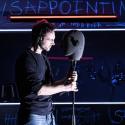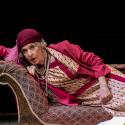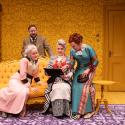Once upon a time... Storytelling is an integral part of all human cultures, and a central pillar of an enlightened education. Some children get the hang of it quickly – they are, as the phrase has it, natural storytellers. This week the Royal Court introduces several youthful writers with Primetime, a series of short plays written by primary school children between the ages of eight and 11.
The new Royal Court playwrights join a sizeable pantheon of young authors, whom we celebrate in this edition of Listed. We have set the rule that, to qualify, the writer had to be under 18 when they picked up their pen. Ours is by no means an exhaustive trawl through the world of extreme precocity. Do let us know in the comments below who you think we left out.
 Dorothy Straight, four: How the World Began
Dorothy Straight, four: How the World Began
The world had barely begun at all for Dorothy Straight (pictured right) when she made her authorial debut in 1962 at the grand old age of four, although she had to wait till she was six before her canny parents sent it off to a publisher. She wrote it for her grandmother, apparently inspired by a production of Britten’s Noye’s Fludde. The story’s creation was completed in an evening, including the illustrations, impressive compared with the six days it took the world’s original creator. Jasper Rees
Daisy Ashford, nine: The Young Visiters
The Young Visiters is a society novel produced by a nine-year-old. Written in 1890, the extraordinarily precocious Daisy Ashford’s tale – a slim volume no less full for all its cogency – follows the romantic travails of Mr Salteena, an “elderly man” of 42, and his vain attempts to enter polite society. It’s a lively social satire, told with a laconic wit all the more potent for being expressed in the glorious original misspellings. “Velvit” dresses, “orange blossums” and “perlite” conversation spice prose of extraordinary poise. Alexandra Coghlan
Alec Greven, nine: How to Talk to Girls
This New York Times bestseller published in 2008 took precocity to fresh frontiers by looking at the dating game through the eyes of a third-grader who was inspired to share his thoughts after watching his peers get it all wrong in the playground. “You don’t want to stick out too much,” was the author’s advice to hopeful young womanisers. Thanks to this self-help book he stuck out quite a lot. Jasper Rees
Anne Frank, 13: The Diary of a Young Girl
Anne Frank started writing her diary on her 13th birthday, 12 June 1942, in the new notebook she’d received as a gift. Its final entry, 1 August 1944, was three days before the Frank family was taken from their Amsterdam hiding-place. As well as recording the circumstances of life (“When I write I can shake off all my cares. My sorrow disappears, my spirits are revived!”), and the experience of a girl’s early adolescence, Frank's diary also shows the shaping of a writer. She began it for her eyes only; later she started to edit it consciously, with a view to it being read as a historical document after the war. Frank died in Bergen-Belsen in February 1945. “I know I can write... but it remains to be seen whether I really have talent,” she had written on 5 April 1944. Since it was first published in the Netherlands in 1947 as The Diary of a Young Girl, readers around the world in their millions have resoundingly endorsed that she did. Tom Birchenough
Jane Austen, 14: Love and Freindship
“They flew into each other’s arms. It was too pathetic for the feelings of Sophia and myself – We fainted alternately on a sofa.” With its breathless plot peppered with fainting fits, Love and Freindship (sic) is remarkable because 14-year-old Jane Austen not only wrote a witty, epistolary novel but also a smart piece of literary criticism. She comically exaggerates the vogue for novels packed with “sensibility” – feverish over-emotionalism falsely suggesting feeling. She examined the selfishness of that with more depth in Sense and Sensibility, but this version has youthful daring. David Benedict
Gideon Sams, 14: The Punk
The Punk was, according to its cover, “the first punk novel – Romeo and Juliet with safety pins". "Novel" stretched things, as it ran to 55 pages. While focusing on Adolph Sphitz’s attraction to the comely Thelma, appropriate backdrops came from a visit to the Roxy Club, scuffles with Teddy Boys and an encounter with Sid Vicious. Sams wrote it as a project while at Westminster City School, and it was published in 1977. He died in New York in 1986. In an unlikely afterlife The Punk was adapted as a film of the same name in 1994. Sadly, Sams missed punk-ted aggro interactions like “Oi, what d’ya think you’re doing to my record, greaseball?” on the big screen. Kieron Tyler
 The Stephen children, various: Hyde Park Gate News
The Stephen children, various: Hyde Park Gate News
Charming parodies of Victorian children’s literature and needle-toothed satire of the adult world characterise Hyde Park Gate News (1891-95), a chronicle by the three Stephen chidren, Virginia (later Woolf), Vanessa and Thoby. Serial comic stories, diary accounts of crucial experiences (that appear later in Woolf’s fiction) and vivacious character sketches make for a delightful and informative portrait. Matthew Wright
The Brontë children, various: Gondal and Angria
Before technology visualised childhood monsters on a screen, literary families would write their own, and the Brontës, you suspect, had plenty of source material. Gondal and Angria, the violent and (in later editions) erotic illustrated fantasy worlds (discussed below) created together by the three sisters and their brother Branwell blend contemporary allusions and the wildest invention, in a kind of Games of Thrones in tiny notebooks. Matthew Wright
Caitlin Moran, 15: The Chronicles of Narmo
Moran’s recently reissued debut shares DNA with similarly semi-autobiographical How to Build a Girl, also featuring a recognisable budding writer and her large, chaotic family. Narmo is more vignettes than fully-fledged novel, but Moran’s celebrated trademarks are all present: surreal, sharply funny observations, class and gender consciousness, and irrepressible optimism. Marianka Swain
 John Kennedy Toole, 16: The Neon Bible
John Kennedy Toole, 16: The Neon Bible
Having a debut novel published nine years after your best-known work is… unusual – but that’s John Kennedy Toole. Bitter family rivalries prevented caustic, coming-of-age novel The Neon Bible, from being published before 1989, 20 years after his death. It was written in 1954, the author just 16 and showing a scintilla of the talent that would produce A Confederacy of Dunces. He would later dismiss it as “a grim, adolescent, sociological attack upon the hatreds caused by the various Calvinist religions in the South. The book, of course, was bad.” Barney Harsent
Malala Yousafzai, 16: I Am Malala
It's hard to imagine the typical teenager having enough material to fill a memoir, but even before she became the youngest ever recipient of the Nobel Peace Prize Malala Yousafzai was hardly a typical teenager. Published a year after the Taliban’s failed assassination attempt, I Am Malala, written with journalist Christina Lamb, is the story of a young activist’s personal and political campaign to improve the rights of women and girls in her native Pakistan. Lisa-Marie Ferla
Françoise Sagan, 17: Bonjour Tristesse
The narrator of Sagan’s vivid short novel is a 17-year-old schoolgirl, Céline, but it was published in 1954 when its rebellious, naïve, contradictory, sophisticated upper-middle-class adolescent author had turned 18: its plot tells of a world-weary cross-generational love affair. The novel caused a lasting sensation which would overshadow its author's considerable later achievements – and publicly unhappy life. Marina Vaizey















Add comment